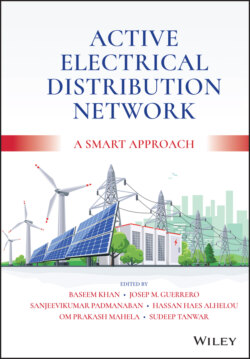Читать книгу Active Electrical Distribution Network - Группа авторов - Страница 58
3.3.1.1 Distribution Losses
ОглавлениеA distribution system offers a linkage between a high-voltage transmission system and low-voltage consumers where heat loss in an overall network is high due to the high current. Distribution system operators have a financial incentive to diminish losses in these networks. This incentive is evaluated as the difference of the evaluated unit price between real and standard losses. Thus, if the real losses are higher as compared to standard losses then the distribution system faces the economic loss and in the opposite situation it gains the profit. Ultimately, this is revealed as a well-researched area as all available methodologies differ from each other in terms of selection of a tool for loss minimization, problem formulation, or problem solution methods executed for obtaining the best solution. Plenty of published formulations and methodologies of loss reduction, like network reconfiguration, capacitor allocation, increased voltage in the distribution system, conduct or grading, distributed generator (DG) insertion, etc., are showcasing their efficacy in improving the performance of the system.
Among all the predefined problems, the most important issue in the distribution system is the unavoidable unintended performance of the distribution sector due to improper design criteria, which leads to high transmission and distribution (T&D) losses, including electricity theft and unrealistic tariffs to consumers. This aspect highlights the financial status of the distribution companies, which is extremely stressed and leads to inadequate investment by the electricity sector, both in generation and in distribution. It also hampers the contribution of private investors toward generation due to the problems projected about the capacity of the unviable distribution companies to pay for power [9]. The power and energy losses in distribution grids are mostly related to energy conversion into heat subjected to the circulation of proportional currents in the line conductors, which is described as the Joule effect [10]. The transmission of electric energy over long lengths are subjected to power losses. The major part of these energy losses derives from the Joule effect in transformers, power lines, and other components in the power system. The energy is lost as heat in the transmission lines. The investigations have revealed that the overall losses lie in the range between 8 and 15%; thus its evaluation and analysis play an important role in calculating the efficiency of the distribution system. Pricing and appropriate cost allocation defining the precise contribution of operators in a power network in the total costs are counted as the most important problem identified along with all other important issues of the restructuring of the power industry. Fair allocation of price among all the contributors in the system is a complicated but still essential part of operating criteria in the electric power market [11].
